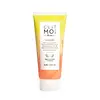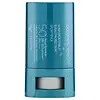What's inside
What's inside
 Key Ingredients
Key Ingredients

 Benefits
Benefits

 Concerns
Concerns

 Ingredients Side-by-side
Ingredients Side-by-side

Zinc Oxide 19%
Cosmetic Colorant1,2-Hexanediol
Skin ConditioningActinidia Chinensis Fruit Extract
EmollientAloe Barbadensis Leaf Juice
Skin ConditioningBeeswax
Emulsion StabilisingButyloctyl Salicylate
Skin ConditioningCaprylic/Capric Triglyceride
MaskingCetearyl Nonanoate
EmollientCoco-Caprylate
EmollientDecylene Glycol
Skin ConditioningFragaria Vesca Fruit Extract
AstringentGlycerin
HumectantHydrogenated Castor Oil
EmollientIsostearic Acid
CleansingLecithin
EmollientMagnesium Sulfate
Phenoxyethanol
PreservativePolyglyceryl-3 Polyricinoleate
EmulsifyingPolyglyceryl-4 Diisostearate/Polyhydroxystearate/Sebacate
EmulsifyingPolyhydroxystearic Acid
EmulsifyingPyrus Malus Fruit Extract
Skin ConditioningShea Butter Ethyl Esters
EmollientSilica
AbrasiveSodium Chloride
MaskingSqualane
EmollientTocopherol
AntioxidantWater
Skin ConditioningZinc Oxide 19%, 1,2-Hexanediol, Actinidia Chinensis Fruit Extract, Aloe Barbadensis Leaf Juice, Beeswax, Butyloctyl Salicylate, Caprylic/Capric Triglyceride, Cetearyl Nonanoate, Coco-Caprylate, Decylene Glycol, Fragaria Vesca Fruit Extract, Glycerin, Hydrogenated Castor Oil, Isostearic Acid, Lecithin, Magnesium Sulfate, Phenoxyethanol, Polyglyceryl-3 Polyricinoleate, Polyglyceryl-4 Diisostearate/Polyhydroxystearate/Sebacate, Polyhydroxystearic Acid, Pyrus Malus Fruit Extract, Shea Butter Ethyl Esters, Silica, Sodium Chloride, Squalane, Tocopherol, Water
Zinc Oxide 13.5%
Cosmetic ColorantSqualane
EmollientJojoba Esters
EmollientEuphorbia Cerifera Wax
Nylon-12
C12-15 Alkyl Benzoate
AntimicrobialButyloctyl Salicylate
Skin ConditioningGlyceryl Dibehenate
EmollientPolymethylsilsesquioxane
Hydrogenated Coco-Glycerides
EmollientPoly C10-30 Alkyl Acrylate
Emulsion StabilisingDimethiconol
EmollientMethylpropanediol
SolventTridecyl Salicylate
Skin ConditioningTribehenin
EmollientC26-28 Alkyl Dimethicone
Skin ConditioningSynthetic Wax
AbrasiveGlyceryl Behenate
EmollientTriceteareth-4 Phosphate
EmulsifyingCaprylyl Glycol
EmollientPhysalis Angulata Extract
Skin ProtectingCaprylic/Capric Triglyceride
MaskingBisabolol
MaskingPhenylpropanol
MaskingDimethylmethoxy Chromanol
AntioxidantTocopheryl Acetate
AntioxidantTocopherol
AntioxidantDimethicone
EmollientIron Oxides
CI 77492
Cosmetic ColorantZinc Oxide 13.5%, Squalane, Jojoba Esters, Euphorbia Cerifera Wax, Nylon-12, C12-15 Alkyl Benzoate, Butyloctyl Salicylate, Glyceryl Dibehenate, Polymethylsilsesquioxane, Hydrogenated Coco-Glycerides, Poly C10-30 Alkyl Acrylate, Dimethiconol, Methylpropanediol, Tridecyl Salicylate, Tribehenin, C26-28 Alkyl Dimethicone, Synthetic Wax, Glyceryl Behenate, Triceteareth-4 Phosphate, Caprylyl Glycol, Physalis Angulata Extract, Caprylic/Capric Triglyceride, Bisabolol, Phenylpropanol, Dimethylmethoxy Chromanol, Tocopheryl Acetate, Tocopherol, Dimethicone, Iron Oxides, CI 77492
Ingredients Explained
These ingredients are found in both products.
Ingredients higher up in an ingredient list are typically present in a larger amount.
Butyloctyl Salicylate is a chemical UV filter structurally similar to octisalate. It is a photostabilizer, SPF booster, emollient and solvent. This ingredient helps evenly spread out ingredients.
According to a manufacturer, it is suitable for pairing with micro Titanium Dioxide, Zinc Oxide, and pigments.
Photostabilizers help stabilize UV-filters and prevents them from degrading quickly.
Learn more about Butyloctyl SalicylateThis ingredient is an emollient, solvent, and texture enhancer. It is considered a skin-softener by helping the skin prevent moisture loss.
It helps thicken a product's formula and makes it easier to spread by dissolving clumping compounds.
Caprylic Triglyceride is made by combining glycerin with coconut oil, forming a clear liquid.
While there is an assumption Caprylic Triglyceride can clog pores due to it being derived from coconut oil, there is no research supporting this.
Learn more about Caprylic/Capric TriglycerideSqualane is an emollient that helps the skin hold onto moisture. It's an oily liquid that occurs naturally in certain types of fish and plant oils.
Because squalane boosts hydration in the skin, it also comes with plenty of benefits: it is an antioxidant and can help fight free radicals and skin damage. Squalane is also found to have a detoxifying effect when applied.
Squalane comes from squalene, which occurs naturally within the sebum of our skin. It is one of the oils our skin produces to keep itself hydrated. Squalane is the hydrogenated version of squalene and has a longer shelf life.
Research shows that squalane is non-irritating (even at 100% concentration).
In general, it's a fantastic ingredient. It does a great job at hydrating the skin, and it's suitable for those with sensitive skin.
The source of squalane may impact malassezia / fungal acne. This is because olive oil derived squalane can contain impurities such as fatty acids and plant waxes. Sugarcane derived squalane is recommended for anyone with malassezia concerns.
Is squalane vegan?
This depends on the source. Squalane can be derived from both plants and animals. Most squalane used in skincare comes from plants.
Please note: the source of squalane is only known if disclosed by the brand. We recommend reaching out to the brand if you have any questions about their squalane.
Read more about squalene with an "e".
Is squalane an oil?
Squalane is often called an oil, but it’s technically not; it’s a hydrocarbon, meaning it’s only made of carbon and hydrogen, unlike true oils which are triglycerides made of fatty acids and glycerol.
The term “oil-free” isn’t regulated, so companies can define it however they want. Some exclude all oils, while others just avoid mineral oil or comedogenic oils.
While some people avoid oils thinking they cause breakouts, the right kind of oil (or oil-like ingredient like squalane) can actually help balance and hydrate your skin. It’s worth testing out simple oils or squalane to see what works best for your skin.
Learn more about SqualaneTocopherol (also known as Vitamin E) is a common antioxidant used to help protect the skin from free-radicals and strengthen the skin barrier. It's also fat soluble - this means our skin is great at absorbing it.
Vitamin E also helps keep your natural skin lipids healthy. Your lipid skin barrier naturally consists of lipids, ceramides, and fatty acids. Vitamin E offers extra protection for your skin’s lipid barrier, keeping your skin healthy and nourished.
Another benefit is a bit of UV protection. Vitamin E helps reduce the damage caused by UVB rays. (It should not replace your sunscreen). Combining it with Vitamin C can decrease sunburned cells and hyperpigmentation after UV exposure.
You might have noticed Vitamin E + C often paired together. This is because it is great at stabilizing Vitamin C. Using the two together helps increase the effectiveness of both ingredients.
There are often claims that Vitamin E can reduce/prevent scarring, but these claims haven't been confirmed by scientific research.
Learn more about TocopherolZinc Oxide is a mineral broad-spectrum UV filter; it is the broadest UVA and UVB reflector approved by the FDA. It also has skin protectant and skin soothing properties.
Zinc oxide is one of the most effective broad-spectrum UV filters. It protects against UVB, UVAII, and UVAI. In comparison to its counterpart titanium dioxide, zinc oxide provides uniform and extended UVA protection.
Another great benefit? This ingredient is highly photostable so it won't degrade easily under sunlight.
A common myth is that mineral UV filters are widely believed to primarily reflect UV light.
However, modern research shows titanium dioxide absorbs UV radiation like chemical filters (~95% absorption & 5% reflection).
Zinc oxide has great skin soothing properties so you'll likely find this in sunscreens formulated for sensitive skin or babies/children. It is unlikely to cause "eye sting" like other sunscreen ingredients.
Regulatory agencies consider zinc oxide to be non-toxic and safe. It has also been shown to not penetrate the skin.
Unfortunately, this ingredient does leave a visible white cast. This is why mineral sunscreens are often less cosmetically elegant than chemical or hybrid ones.
In cosmetics, zinc oxide can be found in both non-nano and nano-sized forms. The nano version is used to reduce white cast and improve the texture of sunscreen formulas.
There are ongoing concerns surrounding nano-zinc oxide's impact on marine ecosystems and whether it can be absorbed into skin.
Regarding marine ecosystems and coral reefs, there is no conclusive evidence that any form of zinc oxide (or any other sunscreen ingredients) will cause harm. The science is still developing but many consumers are keeping a close eye on this issue.
Please note, many destinations have reef-safety sunscreen rules. For instance, the U.S. Virgin Islands advises all visitors to use non-nano mineral sunscreens.
There has also been some stir about whether micronized or nano zinc oxide has potential photoxicity and absorption through the skin/lungs.
An in-vitro (done in a test tube or petri dish) study demonstrated micronized zinc oxide to have potential phototoxicity. There's no need to fret; the EU Commission's Scientific Committee on Consumer Safety has stated, "The relevance of these findings needs to be clarified by appropriate investigations in vivo." Or in other words, further studies done on living organisms are needed to prove this.
Current research shows zinc oxide nanoparticles do not penetrate intact or sunburned skin. They either remain on the surface or in the outermost layer of dead skin (stratum corneum).
Zinc oxide is one of only two classified mineral UV filters with titanium dioxide being the other one.
Fun fact: Zinc has been used throughout history as an ingredient in paint and medicine. An Indian text from 500BC is believed to list zinc oxide as a salve for open wound. The Ancient Greek physician Dioscorides has also mentioned the use of zinc as an ointment in 1AD.
Learn more about Zinc Oxide